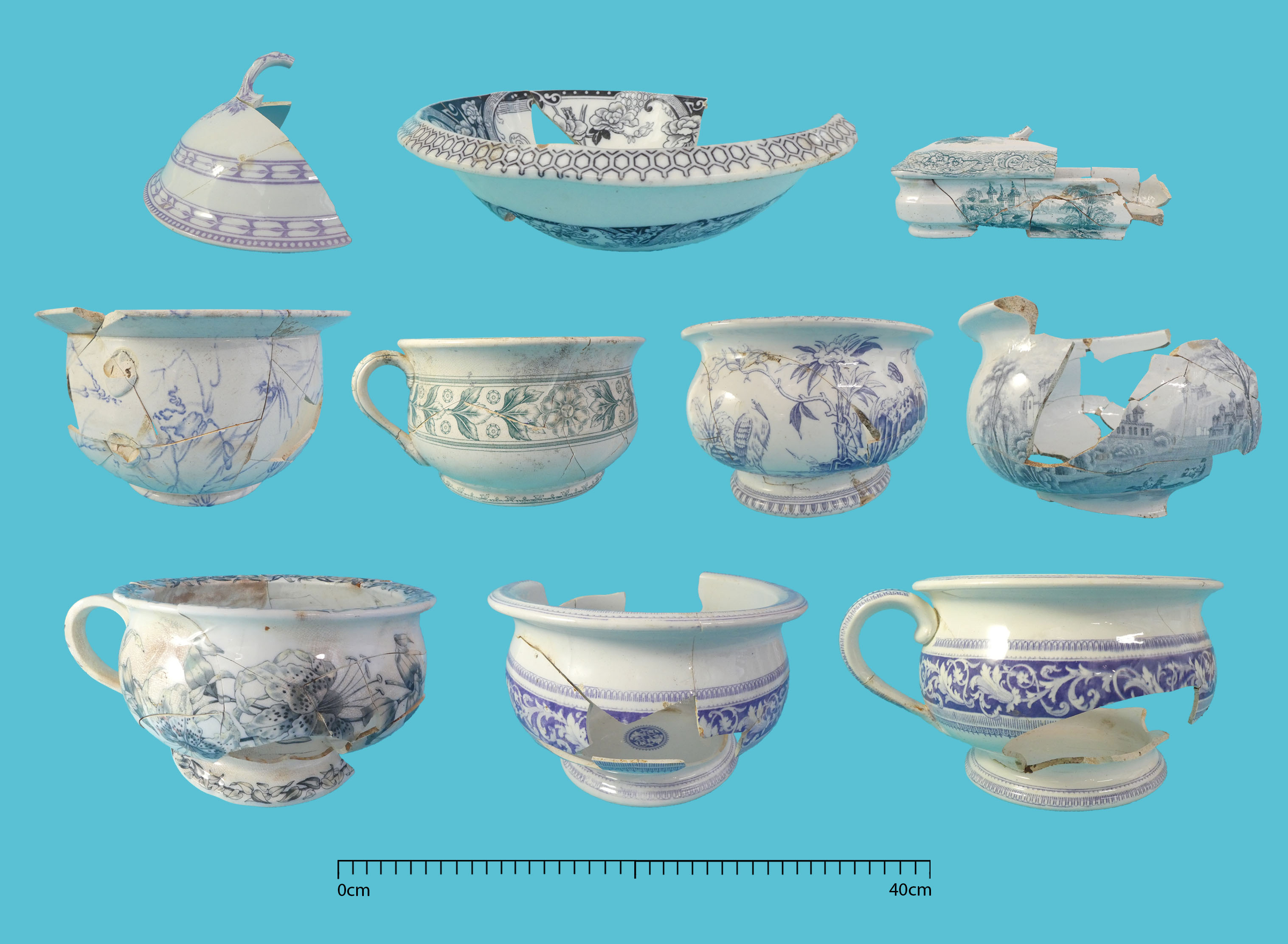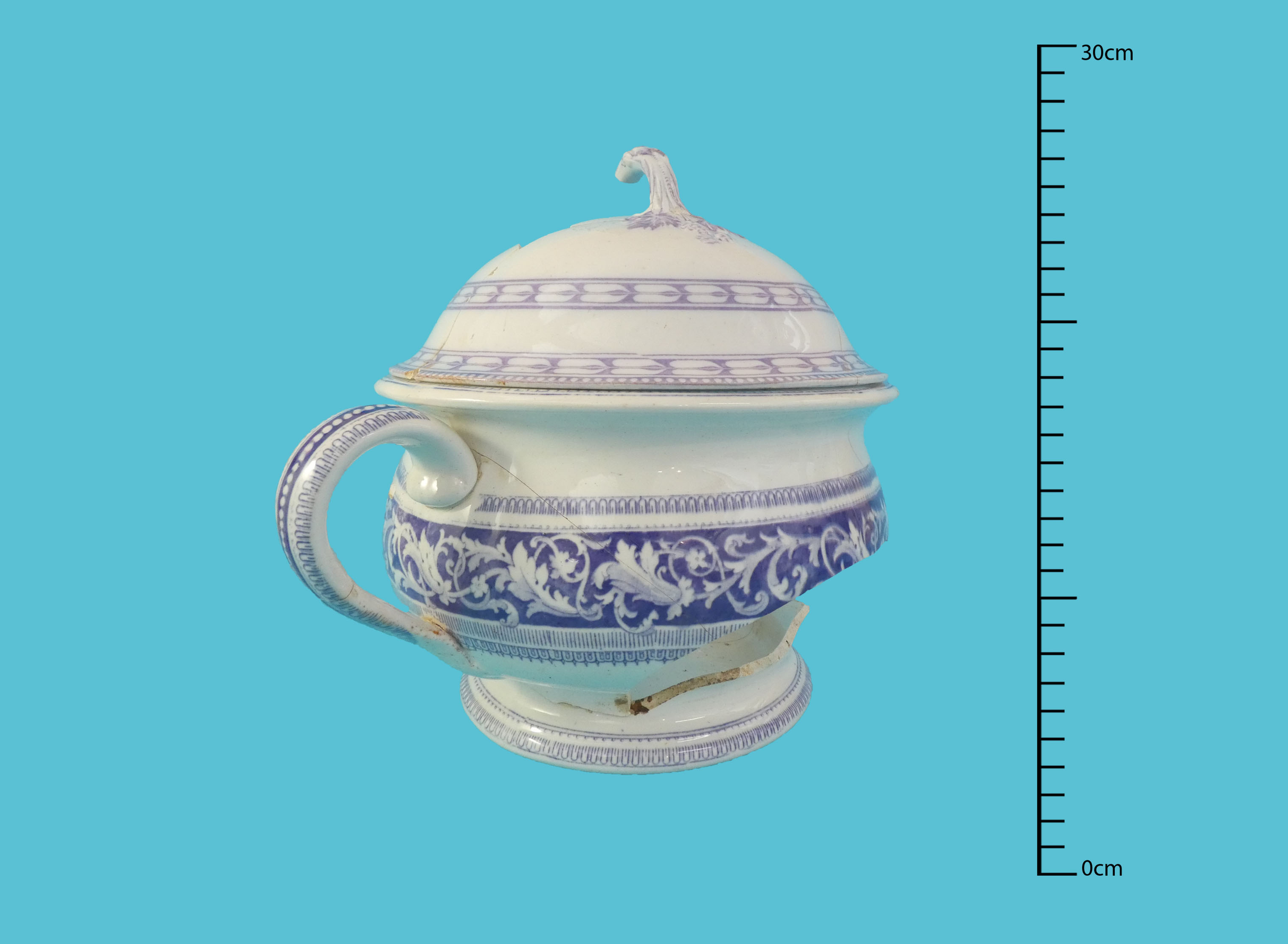In 2019, GML Heritage Pty Ltd (GML) were engaged by ISPT Pty Ltd (ISPT) to undertake an historical archaeological investigation of 364-378 Little Lonsdale Street, Melbourne. This location encompasses two sites listed on the Victorian Heritage Inventory (H7822-1024 and H7822-1025). The sites were used as domestic residences (1864-1918) before the construction of a Women’s VD Clinic (1918) and a Tuberculosis Bureau (1928) (GML 2019). The recovered artefact collection, comprising approximately 40,000 artefact fragments, was catalogued and analysed by Christine Williamson Heritage Consultants.

Photo 1: toilet wares from 364-378 Little Lonsdale Street (photograph by Grace Stephenson-Gordon, Christine Williamson Heritage Consultants)
The items pictured are ceramic artefacts relating to 19th-century hygiene practises. The majority of these items are chamber pots, but a chamber pot lid, wash basin and a brush box and lid were also identified. All are made from earthenware and decorated with transfer printed designs in black, blue, green and purple. These artefacts are from high significance contexts associated with the single-storey cottages of 366, 368 and 370 Little Lonsdale Street.
Concepts of hygiene during the 19th-century were evolving and changing dramatically from those of previous centuries. In earlier eras a link had been made between bathing and the spread of disease, but the people of the 19th-century began to see the relationship between cleanliness and disease prevention, with cleanliness becoming closely tied with a person’s respectability (Davidoff and Hall 2002: 382; Everleigh 2002: 65; Grigg 2008; Halliday 1999: 17). ‘Cleanliness, like good manners became an indicator of respectability while dirt and squalor were seen as threats to moral as well as physical health‘ (Everleigh 2002: 65). Having a full toilet service was therefore highly desirable for 19th-century homes, and would have included items such as the chamber pot (possibly with a cover), large and small wash basins and ewers, a covered soap box with drainer, a covered sponge bowl, a covered toothbrush box or toothbrush vase, a foot bath and many additional extras (Copeland 2000: 24).
The chamber pots excavated from 364-378 Little Lonsdale Street represent the most common hygiene items recovered from 19th-century domestic sites. Chamber pots were stored under the bed or in a nightstand. When looking at the alternative toilet solution of the 19th-century – the water closet – which was located outside the house, the usefulness of the chamber pot is obvious. The chamber pot was a convenient option when needing to use the toilet in the middle of the night as it did not necessitate trudging outside in the cold and dark. In the morning, the pot would be emptied and cleaned and the waste disposed of. But wouldn’t this smell be rather overwhelming when you went back to bed? Yes, strangely enough human waste was no better then, than it is now. In order to minimise odours, chamber pots were usually (but not always) covered with pieces of cloth, newspapers, or a chamber pot lid (as pictured).

Photo 2: chamber pot with lid from 364-378 Little Lonsdale Street (photograph by Grace Stephenson-Gordon, Christine Williamson Heritage Consultants)
REFERENCES
COPELAND, R. 2000: Ceramic Bygones and other unusual domestic pottery. A Shire Book. Great Britain.
DAVIDOFF, L. and C. HALL 2002: ”My own fireside’: the creation of the middle-class home.’ Family Fortunes: Men and Women of the English Middle Class 1780-1850. Revised Edition. London and New York: Routledge, pp. 357-396.
EVELEIGH, D.J. 2002: Bogs, Baths and Basins: The Story of Domestic Sanitation. Stroud, England: Sutton.
GML 2019: 364-378 Little Lonsdale Street, Melbourne, Historical Archaeological Research Design. Report to Case Meallin Pty Ltd & ISPT Pty Ltd.
GRIGG, T. 2008: Health & Hygiene in Nineteenth Century England in Museums Victoria Collections https://collections.museumvictoria.com.au/articles/1615, accessed 02 May 2019.
HALLIDAY, S. 1999: The Great Stink of London: Sir Joseph Bazalgette and the Cleansing of the Victorian Capital. Sutton Publishing Ltd, England.

